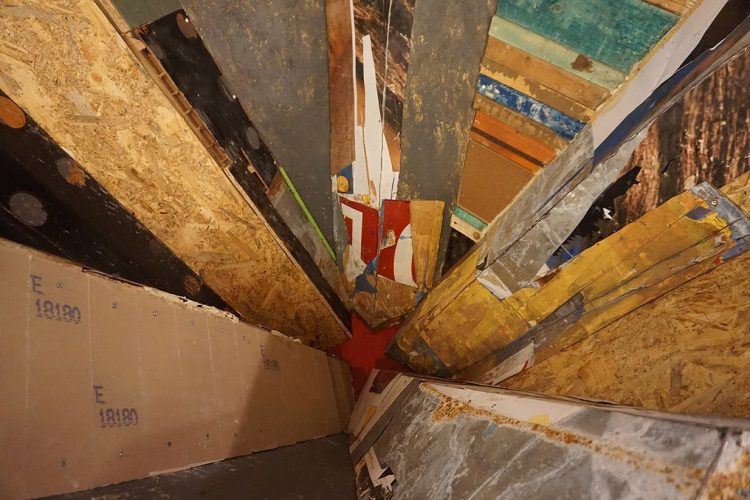AIRLAB SPRING EXHIBITION
June 20- 36, 2016
Zeta Center/ Gallery, Rr. Abdyl Frashëri, Nr: 31, A/4, Hekla Center, Tirana/Albania
Info/Press: contact.tica@gmail.com // mail@the-maps.org Website: www.tica-albania.org // www.the-maps.org
TICA AIRLAB 2016 is made possible through the support of the Ministry of Culture of Albania.
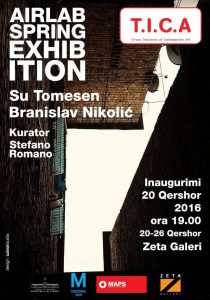
Started in 2006, TICA’s residency program is the only regular and continuous program of its kind in Albania,
providing a very important platform for exchange, research and production. The main profile for AIRLAB is
visual contemporary arts, but since the last three years, the program has been of a multidisciplinary nature, hosting
artists from the fields of theater and film besides visual artists.
The spring 2016 edition of AIRLAB features three artists in residence: Silva Agostini, Branislav Nikolić and
Su Tomesen. All of them engaged in research of themes and context, relating to the city and multiple layers its
history and everyday reality. The processes developed by the artists are still in progress and will be shown in
their final form later on during the year. The finalization of their respective residencies is materialized with this
exhibition AIRLAB SPRING EXHIBITION, featuring works by Su Tomesen and Branislav Nikolic. Although
Nikolic’s work relates more to the historical past of Albania and Tomesen’s deals directly with the everyday
reality and the invisible stories, both approaches constitute some kind of diary or log-book from their stay at
TICA-AIRLAB.
TICA AIRLAB this year is run in collaboration with Zeta Center/Gallery, MAPS – Museum of Art in Public Space
and Stefano Romano was the curator/coordinator of the spring term.
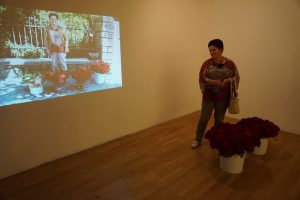
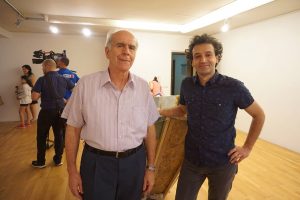
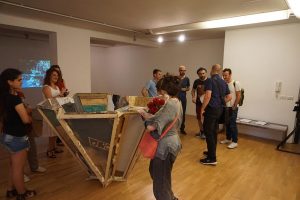
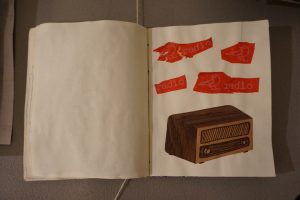
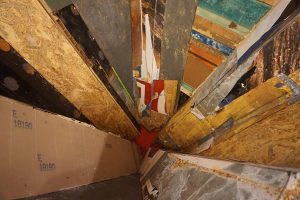
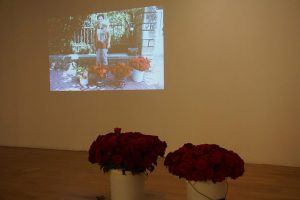
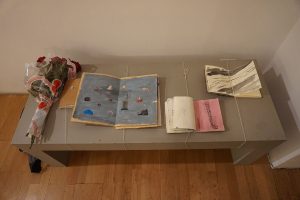
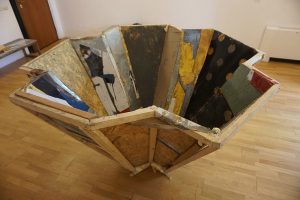
Branislav Nikolić has focused his attention on the details he encountered during his stay. He continuously drew,
pinned, glued and made visual notes on the notebooks built by himself. Items used to occupy public space, bus
tickets, landscapes of the city, rainwater downspouts everything became part of the TIRANA DIARIES, until his
other encounter, that with Enver Hoxha’s pyramid, the decrepit building resembling an empty tomb of a ghost
in the center of the city. The pyramid, built as a memorial to Hoxha and later a center of trade fairs and cultural
activities now closed and left to itself it’s perhaps the most particular architecture in Albania. It’s a “walkable”
building, meaning that everybody feels the irresistible urge to climb its slopes to reach the top. Maybe inspired by its physical and tactile features, Nikolić decided to realize IF THE HAT FITS THE SUIT, a sculpture made
with secondhand materials, wood, iron and other, flipping the building upside down, turning it into an “imploded”
pyramid whose way is no longer ascending but descending. The viewer’s gaze moves from the top of
the sculpture and edges down to the bottom, where a red star is located that, perhaps a little melancholically,
shows itself to the viewer from the bottom of a story which is now part of Albania’s past. It stands as witness to
the common roots of modern Albanian and Balkan’s history that divided and united, but that cannot be ignored
to understand who we are today.
The focus of Su Tomesen’s research was the informal economy, an integral part of the Albanian economic reality.
The final film she is preparing will be screened in September. However, during the shooting of this work the
Dutch artist conceived a new work titled AT THE CORNER. During her residency the artist engaged deeply
with the road, Rr. Myslym Shyri – a place where she was also located – considered one of the most elegant streets
along which you can find many shops selling expensive fabrics, clothes and wedding dresses. Yet, even here
there are micro realities of subsistence that highlighted through the magnifying glass developed by Su, become
much more present than you might notice when walking along the street. Small, fragmented realities of survival
that everyday change and mutate the visual landscape of the road. In her wanderings through the city the artist
came across a woman selling flowers at the eastern corner of the perimeter of Enver Hoxha’s former villa.
Valbona, the florist, is a very polite and smiling lady, always ready to give a flower and a smile to passers-by who
stop to greet her. Even her clothing tells of her love for flowers, jackets with floral designs, colored shirts like
the roses she sells. Su fell “in love” with Valbona for all these characteristics, and day after day their relationship
grew. Su filmed Valbona, Valbona offered flowers to Su, till the moment Su asked Valbona to feature for AT THE
CORNER. The resulting video of an ordinary day of the florist is beamed on a gallery wall, creating a “diptych”
with the florist herself present to sell her flowers. Reality is duplicated in time and space, creating a short circuit
between a one-way media such as video, in which the audience can only look at Valbona selling her flowers, and
the reality in which Valbona, dressed in the same clothes as in the video, sells her flowers to people in the gallery.
It’s as if this repeating gesture in a continuous exchange with the video, transforms reality in the loop of itself.
Stefano Romano
;;;;;;;;;;;;;;;;;;;;;;;;;;;;;;;;;;;;;;;;;;;;;;;;;;;;;;;;;;;;;;;;;;
